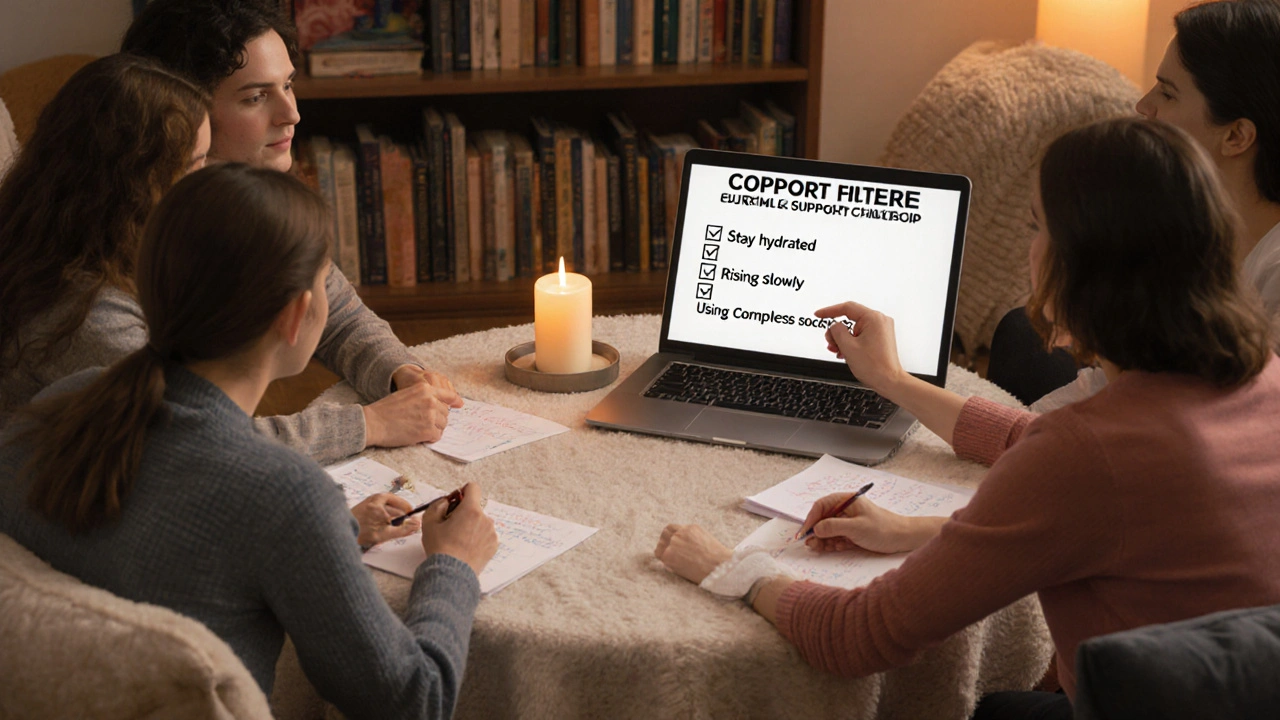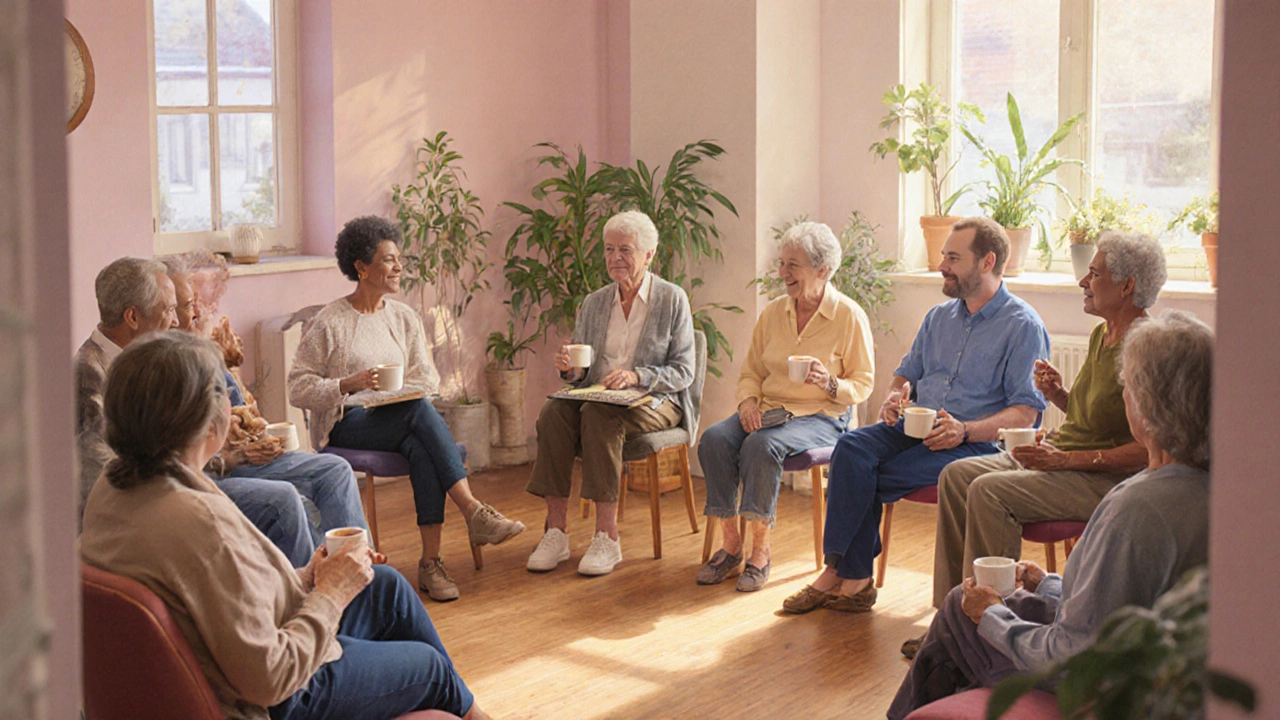Quick Take
- Support groups reduce anxiety and depression by providing shared experiences.
- They deliver practical tips for managing dizziness, fatigue, and sudden drops in blood pressure.
- Peer networks help patients stay updated on the latest research and treatment options.
- Both in‑person and online formats can fit different lifestyles and mobility levels.
- Choosing the right group and setting clear expectations maximizes long‑term benefit.
Living with idiopathic orthostatic hypotension is a daily balancing act. Your blood pressure plummets when you stand, leading to dizziness, fainting, and a cascade of lifestyle restrictions. While medication and medical advice are essential, you’ll quickly discover that the emotional and practical backup from people who truly get it can be a game‑changer. That’s where support groups provide regular meetings-either face‑to‑face or virtual-where patients share stories, coping strategies, and encouragement becomes more than just a nice‑to‑have; it becomes a vital part of managing the condition.
Understanding Idiopathic Orthostatic Hypotension
Idiopathic orthostatic hypotension (IOH) is a form of autonomic dysfunction a failure of the autonomic nervous system to regulate blood pressure when moving upright. "Idiopathic" means doctors haven’t identified an underlying cause like medication side‑effects or neurological disease. Typical symptoms include:
- Light‑headedness or near‑fainting within three minutes of standing
- Blurred vision and fatigue
- Heart palpitations
- Reduced ability to perform daily activities such as grocery shopping or exercising
How Support Groups Work
Support groups bring together people with similar health challenges to exchange information, emotions, and resources. They are usually facilitated by a healthcare provider such as a nurse, social worker, or physician with expertise in autonomic disorders or a peer who has lived with IOH for a considerable time. Meetings can be:
- Weekly or bi‑weekly in a community center, hospital lounge, or church hall
- Monthly virtual gatherings via Zoom, Teams, or dedicated health‑forum platforms
- Hybrid formats that rotate between in‑person and online to accommodate varying mobility levels
Each session typically follows a loose agenda: a brief check‑in, a topic spotlight (like medication side‑effects or safe standing techniques), and open sharing time.
Emotional Benefits: Reducing Anxiety and Depression
Research from the Autonomic Society shows that patients with chronic blood‑pressure disorders who engage in peer support report a 30% reduction in anxiety scores. Knowing you’re not alone validates your experience and lessens the fear of sudden fainting episodes. The group dynamic also encourages the expression of feelings that might otherwise be buried, preventing the buildup of stress that can trigger symptom flare‑ups.
Knowledge Sharing: Real‑World Tips That Clinicians May Miss
Medical appointments often focus on diagnostics and prescription adjustments, leaving little room for day‑to‑day tactics. Support groups fill that gap with actionable advice such as:
- How to layer compression stockings without sacrificing comfort
- Best practices for “room‑to‑stand” exercises that improve vascular tone
- Friendly reminders for carrying a water bottle and small snack to maintain blood volume
- Insights into insurance coverage for assistive devices like tilt‑tables
Because this knowledge comes from lived experience, it’s often more practical and immediately applicable than textbook recommendations.

Practical Management: Building a Routine That Sticks
One of the most powerful outcomes of group participation is the formation of personal accountability circles. Members pair up as “check‑in buddies” who:
- Text each other each morning to confirm they’ve done the recommended fluid intake.
- Schedule weekly video calls to discuss any new symptom patterns.
- Share reminders for upcoming medical appointments.
These simple rituals translate into better adherence to lifestyle modifications, which research links to a 15% improvement in orthostatic blood‑pressure stability.
Finding the Right Group: In‑Person vs. Online
Choosing a format that matches your comfort level and schedule is crucial. Below is a quick comparison to help you decide.
| Feature | In‑Person | Online |
|---|---|---|
| Meeting Frequency | Weekly or bi‑weekly | Monthly or as needed |
| Anonymity | Low - faces are visible | High - can use pseudonyms |
| Cost | Usually free, occasional venue fee | Often free, may need stable internet |
| Accessibility | Depends on travel ability | Can join from home or bedside |
| Peer Diversity | Local community only | National or international participants |
If you struggle with mobility, an online group may be the first step. Conversely, if you thrive on face‑to‑face interaction, seek out a local hospital‑affiliated meeting. Many patients start online and later transition to in‑person sessions when they feel more confident.
Making the Most of Your Participation
To extract maximum value, consider these pro tips:
- Set a personal goal for each meeting-whether it’s learning a new coping technique or simply sharing one success story.
- Take notes. A small notebook or digital document helps you remember specifics like dosage adjustments or equipment brands.
- Volunteer for a facilitator role after a few sessions. Teaching reinforces your own knowledge and builds leadership confidence.
- Ask permission before sharing any medical details publicly. Respecting privacy protects both you and the group.
- Follow up with a trusted healthcare provider to verify any new self‑care advice before implementing it.
Potential Pitfalls and How to Avoid Them
Support groups are not a panacea. Common challenges include:
- Over‑reliance on anecdotal advice-always cross‑check with your clinician.
- Negative emotional contagion-if sessions become overwhelmingly grim, consider a different group or suggest a shift toward solution‑focused topics.
- Time constraints-if meetings clash with work or family duties, negotiate a flexible attendance schedule or switch to a recorded session.
By staying mindful of these issues, you can keep the experience uplifting rather than draining.
Next Steps: Building Your Support Network Today
Ready to get started? Here’s a simple action plan:
- Search for local autonomic disorder clinics, which often host quarterly support meetings.
- Visit reputable online forums such as the Dysautonomia International community and look for IOH‑specific threads.
- Reach out to your physician and ask for a list of recommended groups.
- Attend a trial session-most groups welcome newcomers without commitment.
- After the first meeting, jot down what you liked and what you want more of; use that list to guide future group choices.
Remember, the goal isn’t just to survive the drops in blood pressure; it’s to thrive despite them. A supportive community can turn the uneasy feeling of standing up into a confidence‑boosting routine.

Frequently Asked Questions
Can I join a support group if I’m newly diagnosed?
Absolutely. Many groups welcome newcomers and even have orientation sessions that explain the basics of idiopathic orthostatic hypotension, so you won’t feel lost.
What if I prefer not to share my medical details openly?
Most groups respect anonymity. Online platforms often let you use a username, and in‑person groups usually allow you to speak without disclosing specific diagnoses unless you choose to.
Is there a cost associated with joining?
The majority of support groups are free, especially those run by hospitals or nonprofit organizations. Some may ask for a small donation to cover venue costs, but they never charge a membership fee.
How do I know if the information shared is reliable?
Treat peer advice as supplemental. Verify any medication changes, exercise plans, or device recommendations with your doctor before trying them.
Can family members attend the same support group?
Many groups offer separate sessions for caregivers, recognizing that they have unique concerns. Some welcome families to join the main meetings, but it’s best to ask the facilitator ahead of time.

10 Comments
Hey everyone, just wanted to give a quick shout‑out to anyone thinking about joining a support group – it’s a solid way to set healthy boundaries while still getting the camaraderie you need. I’ve found that keeping the conversation respectful and on‑topic makes the whole experience more uplifting, and a little grammar policing never hurts to keep things clear. If you’re feeling hesitant, remember that even a single meeting can give you fresh coping tricks and a boost of confidence. Keep pushing forward, and don’t be afraid to speak up when something feels off – the group is there to help you stay steady.
I've noticed that many people underestimate how much a simple morning hydration routine can smooth out the worst of the dizzy spells. Sharing that tip in a group setting turns a personal habit into a community standard, which in turn lowers the overall anxiety levels for newcomers. It also creates a natural accountability loop when members remind each other to drink that extra glass of water before getting up.
Wow!!! This is exactly why I love these groups!!! 🙌💪 Sharing real‑world hacks like how to layer compression stockings without feeling like a robot is pure gold!!! And yes, bring your emojis, bring your energy!!! The more we pump positivity into our chats, the more we lift each other up!!! 😊🚀
Living with idiopathic orthostatic hypotension forces us to rethink what stability really means. The physiological drop in blood pressure when standing is just the tip of the iceberg. Beyond the dizziness, the condition reshapes daily routines, social interactions, and even one’s sense of self. Support groups act as a social scaffold, providing both emotional cushioning and a reservoir of practical knowledge. When you hear a fellow member describe a simple trick-like drinking a glass of salty water before getting up-it transforms a vague medical recommendation into an actionable habit. These peer‑derived strategies often bypass the bureaucratic lag that clinicians face when updating protocols. Moreover, the shared narrative validates experiences that doctors may overlook because they are not easily measurable. The collective memory of the group can point you toward resources such as low‑cost compression stockings or community tilt‑table programs that you might never discover on your own. From a psychological standpoint, the mere presence of a supportive audience reduces the cortisol surge that accompanies sudden fainting episodes. Lower cortisol, in turn, stabilizes vascular tone, creating a subtle but measurable physiological feedback loop. Research on chronic autonomic disorders consistently shows that patients engaged in peer support report lower anxiety scores and better adherence to lifestyle modifications. Adherence, as we know, is the single most predictive factor for long‑term blood‑pressure stability in this population. Therefore, the group dynamic is not a peripheral luxury; it is a core component of disease management. Facilitators who understand both the medical nuances and the lived experience can steer conversations toward evidence‑based practice while preserving the group’s authenticity. In practice, encouraging members to keep a shared log of symptom patterns can spark collaborative problem‑solving that outpaces individual trial‑and‑error. Finally, the sense of belonging that emerges from regular meetings counteracts the social isolation that so often accompanies chronic illness.
While I respect the philosophical musings presented, it is essential to ground recommendations in verifiable data, particularly when advising patients across the United Kingdom. The assertion that peer‑derived strategies can replace clinical guidance may inadvertently undermine the authority of our healthcare professionals. Moreover, the claim regarding cortisol's role in vascular tone, although intriguing, requires citation from peer‑reviewed sources before being disseminated as fact. A balanced approach that melds empirical evidence with lived experience would serve readers far better.
Let me add a quick fact: the American Autonomic Society published a meta‑analysis in 2022 indicating that structured peer support yields a 12‑15% improvement in orthostatic tolerance tests. This isn’t just anecdotal; it’s quantified across multiple cohorts. So when you hear members talk about “just feeling better,” there’s a statistical backbone to that sentiment. Also, many groups now incorporate tele‑monitoring devices, allowing participants to share real‑time BP readings, which further validates the collective approach.
It is worth noting that while the data you cite is compelling, the methodology of those studies often lacks a robust control group, which can inflate perceived benefits. Additionally, the reliance on self‑reported outcomes may introduce bias, especially in communities where the desire to affirm group cohesion is strong. A critical appraisal of these limitations should accompany any blanket endorsement of support‑group efficacy.
i gotta say, these groups r great but ppl need 2 watch their grammer. like, "its" vs "it's" matters. also, dont forget to spell "orthostatic" right – it ain't "orthostatic". keep it clean, keep it real, and stay on point.
Look, we’ve all seen the same sloppy spelling nonsense, and it’s time to call it out. If you can’t bother to write "orthostatic" correctly, how can anyone trust the medical advice you’re spewing? Stop hiding behind "passive" tones and start speaking up with the facts-no more lazy mistakes.
Support groups really help people stay hopeful.
Write a comment